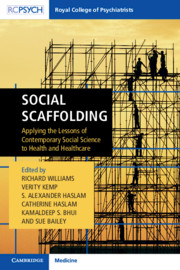Book contents
- Social Scaffolding
- Social Scaffolding
- Copyright page
- Contents
- Contributors
- Foreword
- Note
- Section 1 Schooling
- Section 2 Scoping
- Section 3 Sourcing
- Section 4 Scaffolding
- Chapter 23 Making Connectedness Count: From Theory to Practising a Social Identity Model of Health
- Chapter 24 Public Health Values and Evidence-Based Practice
- Chapter 25 Social Scaffolding: Supporting the Development of Positive Social Identities and Agency in Communities
- Chapter 26 Synthesising Social Science into Healthcare
- Chapter 27 Relationships, Groups, Teams and Long-Termism
- Chapter 28 Caring for the Carers
- Chapter 29 The Importance of Creating and Harnessing a Sense of ‘Us’: Social Identity as the Missing Link Between Leadership and Health
- Chapter 30 Smithtown as Society
- Section 5 Sustaining
- Index
- References
Chapter 23 - Making Connectedness Count: From Theory to Practising a Social Identity Model of Health
from Section 4 - Scaffolding
Published online by Cambridge University Press: 14 June 2019
- Social Scaffolding
- Social Scaffolding
- Copyright page
- Contents
- Contributors
- Foreword
- Note
- Section 1 Schooling
- Section 2 Scoping
- Section 3 Sourcing
- Section 4 Scaffolding
- Chapter 23 Making Connectedness Count: From Theory to Practising a Social Identity Model of Health
- Chapter 24 Public Health Values and Evidence-Based Practice
- Chapter 25 Social Scaffolding: Supporting the Development of Positive Social Identities and Agency in Communities
- Chapter 26 Synthesising Social Science into Healthcare
- Chapter 27 Relationships, Groups, Teams and Long-Termism
- Chapter 28 Caring for the Carers
- Chapter 29 The Importance of Creating and Harnessing a Sense of ‘Us’: Social Identity as the Missing Link Between Leadership and Health
- Chapter 30 Smithtown as Society
- Section 5 Sustaining
- Index
- References
Summary
The purpose of this chapter is to serve as a bridge between the chapters in the previous three sections and those in this fourth section. Thus far, we have sought to analyse the social bases of mental and physical wellbeing. Now, we turn to the question of how the fruits of these analyses can be applied in practice. That is, we have been reporting and interpreting the way the world impacts individual people for long enough; it is time to consider how we might change the world in order to improve our wellbeing.
- Type
- Chapter
- Information
- Social ScaffoldingApplying the Lessons of Contemporary Social Science to Health and Healthcare, pp. 213 - 226Publisher: Cambridge University PressPrint publication year: 2019
References
- 1
- Cited by

